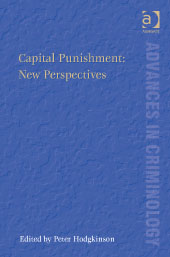 by Peter Hodgkinson (ed). Surrey, England and Burlington, VT: Ashgate, 2013. 408pp. Cloth $154.95. ISBN: 978-1-4724-1220-1.
by Peter Hodgkinson (ed). Surrey, England and Burlington, VT: Ashgate, 2013. 408pp. Cloth $154.95. ISBN: 978-1-4724-1220-1.Reviewed by Mary Welek Atwell, Department of Criminal Justice (retired), Radford University. matwell [at] radford.edu
pp.231-232
A number of reviewers for LPBR have commented recently on the difficulty of discussing books that are collections of disparate articles, often related to each other only in the most tangential way. CAPITAL PUNISHMENT: NEW PERSPECTIVES edited by Peter Hodgkinson certainly fits that profile. True to the title, it offers perspectives on capital punishment, but it is not clear that a collection of articles that somehow touch on the larger subject is enough for a coherent book.
The collection begins with a rather peculiar introduction in which the editor, himself a critic of capital punishment, challenges both the arguments and the strategies of those who work to abolish executions. I should offer a disclaimer at the outset. I support the National Coalition to Abolish the Death Penalty and the Texas Coalition to Abolish the Death Penalty and serve on the board of Virginians for Alternatives to the Death Penalty. Therefore, my own belief in the need to end capital punishment does have an impact on my reaction to the arguments in this volume. But my problem with Hodkinson’s claims is not that he disagrees with abolitionists but that he mischaracterizes their position. His own organization, the Centre for Capital Punishment Studies (CCPS), apparently rejects the strategy of individual litigation of capital cases in favor of developing humane policies to replace the death penalty. No one would argue with that. However, his characterization of the “abolition industry” as “richly resourced” characterized by a “profligate use of resources” would be unrecognizable to most who work against capital punishment in the United States. In addition, few see abolition efforts and efforts to reform the larger criminal justice system as mutually exclusive. But it is against this paper tiger that the editor positions the book.
Hodgkinson states that the “new perspectives” mentioned in the title involve the work not of “career academics” but of those who have a working knowledge of their subject. The first half looks at a great variety of questions about capital punishment, ranging from children of parents sentenced to death to internships working with death penalty cases to juveniles sentenced to death in Islamic societies. It is difficult to see a unifying theme. The second half of the book offers analyses of a great variety of countries and their past and present capital regimes. Although a number of those chapters stand on their own as interesting studies of policies in African and Asian countries, there is little coherence among them. Some are extremely specific – focusing on a landmark case in Malawi – while others look at historical issues such as the use of the death penalty in Romania between [*232] 1969 and 1989. It may be that someone with an interest in a particular country’s capital law will turn to one of these chapters for a deeper understanding. However, without some effort to develop the relationships among the national experiences it is difficult to see why they have been published together.
Although the effort to position the book as an argument opposed to abolition efforts and the omnibus approach to including chapters may diminish its appeal, it does contain some valuable contributions. Several sections written by people who work in the field with capital cases shed light on neglected topics. Two chapters focus on the families of condemned inmates, certainly a neglected population. Here the authors discuss not only the stigma that goes with having a relative sentenced to death but also the cruelty of prison regimens that isolate the person to be executed from human contact. The article notes that there is little or no financial or emotional support for the inmate’s family, although it can be argued that they too are victims. Another chapter examines the experience of children of parents sentenced to death. Although the author believes a quantitative approach to the question would be valuable, it seems more realistic to gather this data using a qualitative approach. In depth interviews with such children, especially if they could be done as a longitudinal study, would surely yield a deeper sense of an often forgotten cost of capital punishment.
The chapter that looks at those who are typically considered the victims of a capital offense, the family members of the murdered person, makes a strong argument that these survivors often want something other than retribution. It challenges the notion that murder victims’ families always press the state to kill the murderer so they will have “closure.” Instead, as groups like Murder Victims’ Families for Reconciliation advocate, the relatives are more likely to find peace by affirming the value of life, even the life of the offender.
It is likely that libraries will be the major purchasers of this volume. And if, in their collections, it is available to students and researchers who want to consult a particular chapter, it will be a useful addition to the literature on capital punishment.
Copyright 2014 by the Author, Mary Welek Atwell.